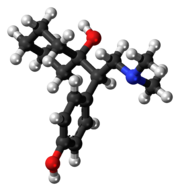User:Mr. Ibrahem/Desvenlafaxine
{{#unlinkedwikibase:id=Q2419445}}
 | |
 | |
| Clinical data | |
|---|---|
| Trade names | Pristiq, Desfax, Ellefore, others |
| Other names | O-desmethylvenlafaxine |
| AHFS/Drugs.com | Monograph |
| MedlinePlus | a608022 |
| License data |
|
| Pregnancy category |
|
| Routes of administration | By mouth |
| Drug class | Serotonin-norepinephrine reuptake inhibitor[1] |
| Legal status | |
| Legal status | |
| Pharmacokinetic data | |
| Bioavailability | 80% |
| Protein binding | Low (30%) |
| Metabolism | CYP3A4, (CYP2D6 is not involved) |
| Elimination half-life | 11 h |
| Excretion | 45% excreted unchanged in urine |
| Identifiers | |
| |
| Chemical and physical data | |
| Formula | C16H25NO2 |
| Molar mass | 263.381 g·mol−1 |
| 3D model (JSmol) | |
| |
| |
| | |
Desvenlafaxine, sold under the brand name Pristiq among others, is a medication used to treat major depressive disorder.[1] It is recommended that the need for further treatment be occasionally reassessed.[1] It appears less effective than its parent compound venlafaxine.[3] It is taken by mouth.[1]
Common side effects include dizziness, trouble sleeping, increased sweating, constipation, sleepiness, anxiety, and sexual problems.[1] Serious side effects may include suicide in those under the age of 25, serotonin syndrome, bleeding, mania, and high blood pressure.[1] A withdrawal syndrome may occur if the dose is rapidly decreased.[1] It is unclear if use during pregnancy or breastfeeding is safe.[4] It is an antidepressant of the serotonin-norepinephrine reuptake inhibitor (SNRI) class.[1]
Desvenlafaxine was approved for medical use in the United States in 2008.[1] Use in Europe was declined in 2009.[3] In the United States the wholesale cost is about 25.20 USD per month.[5] In 2017, it was the 235th most commonly prescribed medication in the United States, with more than two million prescriptions.[6][7]
References[edit]
- ^ a b c d e f g h i j "Desvenlafaxine Succinate Monograph for Professionals". Drugs.com. American Society of Health-System Pharmacists. Archived from the original on 29 March 2019. Retrieved 18 March 2019.
- ^ "WHOCC - ATC/DDD Index". www.whocc.no. Archived from the original on 21 January 2021. Retrieved 7 September 2020.
- ^ a b "Withdrawal Assessment Report for Dessvenlafaxime" (PDF). EMA. p. 3. Archived (PDF) from the original on 22 March 2019. Retrieved 22 March 2019.
- ^ "Desvenlafaxine Pregnancy and Breastfeeding Warnings". Drugs.com. Archived from the original on 29 November 2018. Retrieved 19 March 2019.
- ^ "NADAC as of 2019-02-27". Centers for Medicare and Medicaid Services. Archived from the original on 2019-03-06. Retrieved 3 March 2019.
- ^ "The Top 300 of 2020". ClinCalc. Archived from the original on 12 February 2021. Retrieved 11 April 2020.
- ^ "Desvenlafaxine - Drug Usage Statistics". ClinCalc. Archived from the original on 12 April 2020. Retrieved 11 April 2020.
